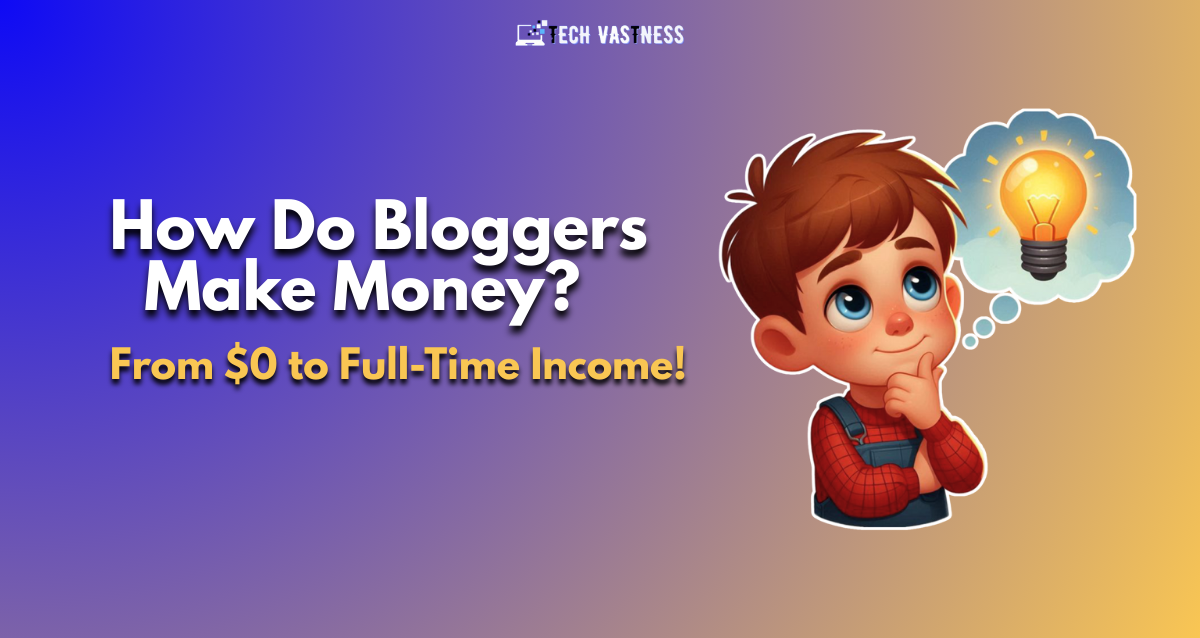Have you ever wondered how bloggers turn simple articles into a full-time income? You’re not alone. In today’s digital world, blogging is no longer just a hobby — it’s a serious income source for millions around the globe.
From sponsored content and affiliate marketing to ad revenue and digital products, bloggers are finding creative ways to monetize their passion. But how exactly does it work?
In this post, we’ll break down the real strategies top bloggers use to make money online — no fluff, just actionable insights. How do bloggers make money? Let’s go.
How Do Bloggers Make Money?
Professional bloggers generate income through various strategies, including affiliate marketing, content sponsorships, advertising, online sales, gated content, and other premium content offerings.
By combining these strategies, new bloggers can earn between $500 and $2,500 per month.
🟩 1. Display Advertising (Google AdSense and Beyond)
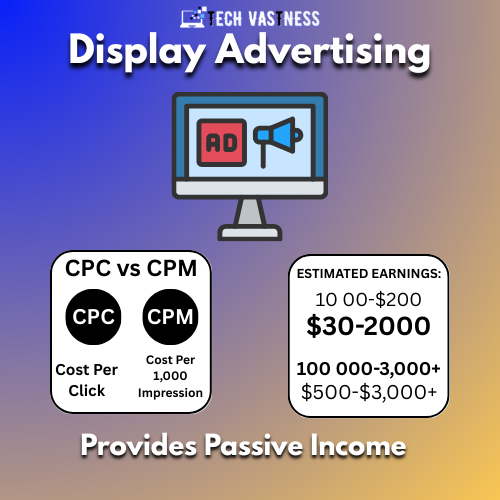
What It Is
When people ask “how do bloggers make money?”, display advertising is often one of the first answers that comes to mind. It’s a simple yet effective way for bloggers to monetize their content by showing ads directly on their website. These ads can be in the form of banners, sidebars, in-content placements, or even pop-ups.
Google AdSense is a widely recognized platform for display advertising, enabling bloggers to show ads that are tailored to their content and the interests of their audience. Every time a visitor views or clicks on an ad, the blogger earns money. Apart from AdSense, there are premium ad networks like Ezoic, Mediavine, and AdThrive, which offer higher payouts and better ad optimization — though they often require a minimum traffic threshold to join.
Display advertising is considered one of the most passive income sources for bloggers because it runs automatically once set up.
How Much Can You Earn from Ads?
The income from display advertising can vary significantly depending on your blog’s niche, traffic volume, and audience location. Bloggers are typically paid either through CPM (cost per thousand impressions) or CPC (cost per click).
For example:
- A tech or finance blog targeting US visitors might earn $10–$30 per 1,000 views with premium ad networks.
- If your blog targets a smaller niche or gets traffic from countries with lower advertising rates, you might earn around $1 to $5 for every 1,000 page views.
Here’s a rough idea of ad income potential:
- 10,000 monthly pageviews = $30–$200/month
- 100,000+ monthly pageviews = $500–$3,000+/month (depending on ad network and niche)
While display ads alone might not make you rich overnight, they’re a great way to build consistent, scalable income, especially when combined with other monetization methods.
Example: TechCrunch is a very popular blog that strategically places ads in its posts.
Read Also: How to Increase Your Site Traffic? 34 Best Ways!
🟩 2. Affiliate Marketing – A Smart Way Bloggers Make Money
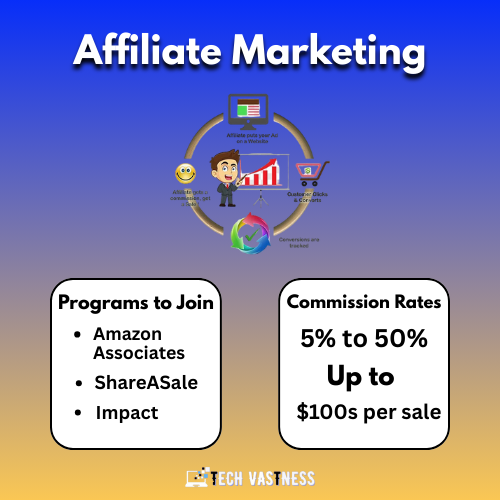
How Affiliate Links Work
One of the most practical answers to how do bloggers make money is by using affiliate links. But how do these links actually work?
When a blogger joins an affiliate program, they receive a unique tracking link for each product or service they choose to promote. This link is then added to blog posts, buttons, images, or banners. When a reader clicks on the link and makes a purchase (or completes a specific action like signing up), the blogger earns a commission — without doing any selling themselves.
Affiliate links use cookies to track user behavior for a set time (e.g., 24 hours, 7 days, or even 90 days). This means that if a user clicks your link today and buys something tomorrow, you still get paid. It’s a win-win model: the brand gets new customers, and the blogger earns passive income by connecting readers with helpful tools or products.
🔹Amazon Associates
- One of the most beginner-friendly programs.
- Offers millions of physical products to promote.
- Commission rate: 1%–10% depending on category.
- Cookie duration: 24 hours.
🔹ShareASale
- A large network with thousands of merchants across fashion, tech, health, and more.
- Bloggers can promote multiple products from one dashboard.
- Trusted by many lifestyle and review bloggers.
🔹 Impact
- High-quality affiliate programs for software, SaaS, and digital tools.
- Popular among tech, finance, and marketing bloggers.
- Offers performance insights and custom commissions.
🔹 CJ Affiliate (Commission Junction)
- Great for bloggers in travel, finance, and e-commerce.
- Connects you with top brands like TripAdvisor, GoDaddy, and Overstock.
- Advanced reporting tools are available.
🔹PartnerStack
- Focused on SaaS (Software as a Service) tools.
- Ideal for tech and digital marketing bloggers.
- Often offers recurring commissions.
🔹 Creative Market & Envato Elements
- Perfect for bloggers in design, content creation, or WordPress themes.
- Promote digital goods like templates, stock assets, and plugins.
Whether you’re just starting out or already getting traffic, affiliate marketing offers one of the most scalable and low-risk ways to monetize your blog. The key is to promote products that match your audience’s needs and create content that naturally leads to clicks and conversions.
Read Also: How to Google Alerts Set Up in 4 Simple Steps!
How Much Can You Earn from Affiliate Marketing?
Earnings from affiliate marketing vary based on your blog’s traffic, niche, and the commission rates of the products you promote. Here’s a general breakdown:
The Amazon Associates program usually offers a commission ranging from 1% to 10% of the product’s sale price, based on the specific category.
Digital products (like courses or software) often pay 30%–70% commissions, making them very lucrative.
Bloggers with targeted traffic and high-converting content can earn $100 to $10,000+ per month through affiliate marketing alone.
For example:
A beginner blogger with 10,000 monthly visitors might earn $50–$300/month.
An experienced blogger in a high-paying niche can earn $1,000–$5,000/month or more from well-placed affiliate links.
Affiliate marketing rewards bloggers who build trust with their audience and create helpful, solution-focused content. Over time, this strategy can become one of the most sustainable ways to monetize a blog.
Example: The Wirecutter is a popular review website blog that utilizes affiliate ads to monetize.
Read Also: How to Write a Headline: A Complete Guide For Beginners!
🟩 3. Sponsored Posts & Brand Collaborations
How Bloggers Work with Brands
When it comes to answering how do bloggers make money, sponsored posts and brand collaborations are among the most profitable methods, especially for bloggers with an engaged audience.
In a sponsored post, a brand pays the blogger to create content that promotes its product or service. This can take the form of a blog article, product review, tutorial, comparison post, or even social media mentions. Unlike affiliate marketing, where income depends on clicks or sales, sponsored content typically involves a fixed payment upfront, which makes it appealing to bloggers looking for predictable income.
Bloggers usually collaborate with brands that align with their niche and audience. For example, a tech blogger might promote a new app, while a fitness blogger may work with a protein supplement company. Brands approach bloggers either directly or through influencer platforms like Intellifluence, Influencity, Aspire, or Get Blogged, where creators can apply for paid blogging opportunities.
The key to successful collaborations lies in trust and authenticity — when readers believe in your recommendations, brands get better results, and you get more repeat sponsorship deals.
How Much Do Sponsors Pay?
Sponsor payouts can vary significantly depending on the blog’s niche, traffic, authority, and engagement level. There’s no universal rate, but here are some common pricing benchmarks:
- Beginner bloggers (with <10K monthly views): $50 – $200 per post
- Intermediate bloggers (10K–50K monthly views): $200 – $800 per post
- Established bloggers (50K+ views or strong domain authority): $1,000 – $5,000+ per post
If your blog has strong SEO or a loyal email list, you can command higher rates. Additionally, bundling services like blog post + Instagram mention + newsletter feature allows bloggers to charge premium prices.
Many successful bloggers also create media kits — one-pagers that showcase traffic stats, audience demographics, previous collaborations, and pricing, making it easier to attract sponsors professionally.
Read Also: What is Clickbait & Why Does it Work: A Ultimate Guide!
🟩 4. Selling Digital Products (eBooks, Courses, Templates)
Best Digital Products to Sell
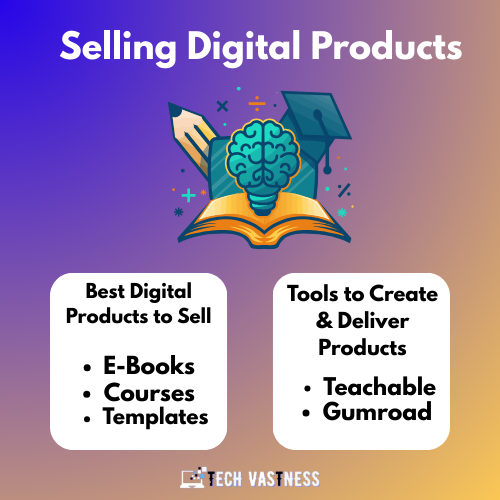
Another powerful answer to the question of how bloggers make money is by selling digital products directly to their audience. Unlike ads or affiliate links, digital products give bloggers full control over their income, profit margins, and customer relationships.
These are some highly popular and lucrative digital products that many bloggers offer for sale:
- eBooks: Ideal for bloggers who want to dive deep into a topic and package it as a downloadable guide or tutorial. Great for niches like self-improvement, finance, fitness, or blogging.
- Online Courses: Perfect for bloggers who can teach a specific skill (e.g., SEO, photography, Pinterest marketing, coding). Courses can be sold for $20 to $500+, depending on the value.
- Printables & Planners: Highly popular in niches like parenting, lifestyle, education, and productivity. These are downloadable PDFs that provide value and help readers stay organized.
- Templates: Useful for business bloggers, designers, and marketers. Examples include content calendars, media kits, pitch decks, or Canva templates.
- Memberships & Premium Newsletters: Recurring income models where readers pay monthly for exclusive access to premium content or tools.
The beauty of digital products is that you create them once and sell them repeatedly — making them a scalable, passive income source.
Tools to Create & Deliver Products
Creating and delivering digital products has never been easier — thanks to a wide range of user-friendly tools available online. Below are some of the top platforms commonly used by bloggers:
🔹 Canva & Google Docs
- Great for designing eBooks, checklists, and templates.
- Canva is especially helpful for beautiful, brand-consistent designs without needing graphic design skills.
🔹 Teachable, Thinkific, & Podia
- Ideal platforms for hosting and selling online courses.
- Allow you to upload video content, quizzes, PDFs, and more with built-in payment systems.
🔹 Gumroad & Payhip
- Excellent for selling eBooks, templates, or printables.
- Provide easy digital delivery, payment processing, and even affiliate options.
🔹 SendOwl & ThriveCart
- Powerful tools for setting up product sales funnels.
- Offer upsells, email integrations, and secure digital file delivery.
🔹 WooCommerce (for WordPress blogs)
- Perfect for bloggers who want to sell directly from their own site.
- You can use WooCommerce with downloadable product extensions to sell files like PDFs, ZIPs, etc.
With the right tools, even beginner bloggers can create polished digital products and build a reliable income stream from their expertise.
Read Also: How to Write Listicles Content 7 Step Best Guide!
🟩 5. Offering Freelance Services
Examples: Writing, Design, Consulting
A powerful yet often underrated answer to how do bloggers make money is by offering freelance services. Many bloggers start out by building an audience through helpful content, and then monetize that visibility by providing services in their area of expertise.
Here are some common freelance services bloggers offer:
- Content Writing & Copywriting: Ideal for bloggers in niches like marketing, tech, health, and finance. Brands often hire bloggers to write SEO blog posts, email newsletters, or ad copy.
- Graphic & Web Design: Design-savvy bloggers can offer services like logo creation, website mockups, or branding kits — especially valuable in the creative and business space.
- SEO & Digital Marketing Consulting: Bloggers with proven experience in traffic growth, keyword research, or Pinterest marketing can offer 1:1 strategy sessions or audits.
- Virtual Assistance: Some bloggers offer VA services like content scheduling, email management, or social media support for busy entrepreneurs.
- Coaching & Mentorship: Bloggers in self-development, productivity, or lifestyle niches often coach individuals looking for personal or career growth.
Offering services helps bloggers build high-ticket income, especially in the early stages when passive income streams like ads or affiliate marketing take time to grow.
How to Attract Clients Through Your Blog
Your blog is more than just a content platform — it’s a powerful portfolio and client acquisition tool when used strategically. Here’s how bloggers attract freelance clients:
✅ 1. Create a “Hire Me” Page
- Clearly list the services you offer, pricing (if applicable), testimonials, and a contact form.
- Highlight your expertise, tools you use, and types of clients you’ve helped.
✅ 2. Publish Problem-Solving Content
- Write blog posts that demonstrate your skills. For example, if you offer SEO audits, publish content like “10 SEO Mistakes Most Bloggers Make.”
- These posts build trust and position you as an expert.
✅ 3. Use CTAs (Calls-to-Action) in Blog Posts
- Add subtle CTAs like “Need help with this? Hire me here” in relevant blog posts.
✅ 4. Leverage LinkedIn & Social Media
- Share your blog content on platforms where potential clients hang out.
- Use your bio and profile banners to promote your services.
✅ 5. Showcase Results
- If you’ve helped a brand or blogger grow their traffic, conversions, or design — show before-and-after results or publish a case study.
By offering freelance services, bloggers can turn their blog into a lead generation machine, earning consistent income while building authority in their niche.
🟩 6. Memberships & Paid Communities
Platforms to Use (Patreon, Buy Me a Coffee)
For bloggers looking to create a reliable, recurring income stream, memberships and paid communities offer a great solution. When people ask how do bloggers make money beyond ads and affiliates, this method stands out as a way to earn directly from loyal followers.
Memberships work by offering exclusive content, resources, or access in exchange for a monthly or one-time payment. Instead of relying on traffic alone, bloggers build a community of superfans who are willing to pay for deeper value.
Here are some of the best platforms to get started:
🔹 Patreon
- One of the most popular platforms for creators.
- Let you set up multiple membership tiers (e.g., $5/ 5/month, $15/month) with different perks.
- Ideal for bloggers offering exclusive articles, Q&A sessions, templates, or early content access.
🔹 Buy Me a Coffee
- Great for bloggers who want a more casual donation or tip-based system.
- Also supports memberships and digital product sales.
- Simple to set up and integrate with your blog or email newsletter.
🔹 Ko-fi
- Offers both one-time donations and membership options.
- Also supports selling downloads, commissions, and even physical products.
These platforms allow bloggers to monetize directly from their community — no ads or sponsors needed — which creates a strong sense of ownership and creative freedom.
Pros & Cons of Membership Models
Like any monetization strategy, membership-based blogging has its own strengths and challenges. Here’s a breakdown to help you decide if it’s right for you:
✅ Pros:
- Predictable Recurring Revenue: Monthly payments create a more stable income.
- Closer Community: Paid members are usually more engaged and loyal.
- Creative Freedom: No dependency on brand sponsors or algorithm changes.
- High Profit Margins: No middlemen; you keep most of the revenue.
❌ Cons:
- Requires Consistent Content: Members expect regular value (e.g., weekly updates, downloads).
- Harder to Scale Fast: It may take time to build enough paying members.
- Marketing Effort Needed: You’ll need to promote your memberships actively across blog posts, email lists, and social media.
- Content Management: You may need extra tools or systems to manage member-only access and delivery.
If you’re committed to delivering ongoing value and building strong reader relationships, launching a paid membership can be one of the most sustainable ways bloggers make money in 2025 and beyond.
Read Also: How to Create an SEO Strategy? 12 Ways Best Guide!
🟩 7. Email List Monetization
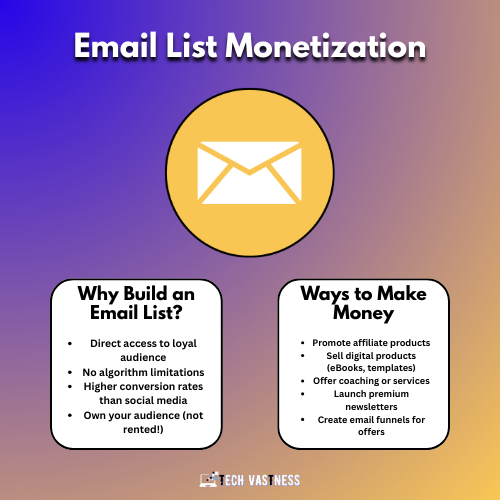
Why an Email List Is Key
When exploring how do bloggers make money, one strategy often overlooked by beginners is email list monetization. Yet, it’s one of the most powerful and reliable income channels available.
Unlike social media platforms, where algorithms control visibility, your email list is an asset you own and control. It allows you to communicate directly with your most engaged audience — people who have already shown interest in your content.
An email list helps build trust and loyalty, which are crucial when you’re recommending products, launching services, or selling digital goods. Studies show that email marketing delivers one of the highest ROI in online business, often outperforming social media or ads.
Whether you have 100 or 10,000 subscribers, your list can become a consistent source of income when used strategically.
Ways to Make Money from Your Subscribers
Monetizing your email list isn’t just about sending sales emails — it’s about offering value while guiding readers toward helpful solutions. Here are some proven methods bloggers use to earn through their list:
🔹 1. Promote Affiliate Products
- Add your affiliate links within helpful newsletters or product roundups.
- Create “resource of the week” or “tool I love” sections to subtly promote offers.
🔹 2. Sell Digital Products
- Launch your own eBooks, templates, or mini-courses directly to your subscribers.
- Offer limited-time discounts or early access to boost urgency and conversions.
🔹 3. Offer Coaching or Services
- Use your list to share case studies or testimonials and invite readers to book a call.
- Include a “Work With Me” call-to-action in your welcome series.
🔹 4. Run Paid Newsletters or Memberships
- Create exclusive email-only content or perks and charge subscribers a monthly fee via platforms like Substack or ConvertKit Creator Pro.
🔹 5. Launch Product Funnels
- Build an email funnel that nurtures new subscribers with value-packed content before introducing a product or offer.
- Use email automation tools like MailerLite, ConvertKit, or Flodesk to streamline the process.
Bloggers who focus on relationship-driven emails — not just promotions — often see higher open rates, clicks, and sales. Over time, this becomes one of the most profitable and scalable ways to monetize a blog.
Read Also: How to Research Keywords: Start to Last Practical Guide!
🟩 8. Blogging + YouTube or Podcasts (Multi-channel Income)
Repurposing Content for Multiple Platforms
In the digital creator economy, one of the smartest ways to scale income is by repurposing blog content across multiple platforms. When discussing how bloggers make money, this strategy opens the door to additional revenue streams, without always creating content from scratch.
For example:
- A blog post can be turned into a YouTube video script, a podcast episode, or short-form content like Instagram Reels or YouTube Shorts.
- A how-to guide on your blog can become a visual tutorial for YouTube or an insightful audio discussion on a podcast.
By doing this, bloggers expand their reach, tap into new audiences, and build authority across different content formats — all while promoting the same core message.
Not only does this drive traffic back to the blog, but it also allows creators to monetize multiple channels simultaneously.
Revenue Streams from YouTube & Podcasts
Adding YouTube or podcasting to your blogging strategy unlocks extra income opportunities beyond traditional ads or affiliate links. Here’s how:
🔹 YouTube Monetization:
- AdSense Revenue: Once your channel meets the YouTube Partner Program requirements (1,000 subscribers + 4,000 watch hours), you can earn through ads shown on your videos.
- Affiliate Links: Just like in blog posts, you can promote affiliate products in your video descriptions and earn commissions.
- Sponsorships: Brands often pay YouTubers for product mentions, reviews, or dedicated videos.
- Merch & Digital Product Sales: Drive traffic to your own products or courses linked in video descriptions.
🔹 Podcast Monetization:
- Sponsorships: Brands may pay for shoutouts or sponsored segments.
- Fan contributions through platforms such as Buy Me a Coffee or Patreon allow supporters to financially back your content.
- Affiliate Mentions: Mention your affiliate products during episodes and link them in show notes.
- Premium Episodes or Subscriptions: Offer bonus content to paying listeners via platforms like Apple Podcasts Subscriptions or Supercast.
By diversifying your content across platforms, you build a multi-channel business that doesn’t rely solely on blog traffic, making your income more stable and scalable.
Read Also: How to Do SEO for Website: 12 Tips Improve Website!
🟩 Final Thoughts: Can You Still Make Money Blogging in 2025?

Absolutely — blogging is still a profitable path in 2025, but success looks different than it did a decade ago. With growing competition and changing algorithms, today’s bloggers need to be strategic, consistent, and value-driven.
The good news? You no longer have to rely on just one income stream. As we’ve explored throughout this post, how do bloggers make money now includes everything from display ads and affiliate marketing to selling digital products, offering services, launching memberships, and expanding onto platforms like YouTube and podcasts.
If you focus on solving real problems, building a loyal audience, and monetizing multiple ways, blogging can still offer financial freedom, creative control, and long-term rewards.
Whether you’re just starting out or scaling an established blog, the key is simple: deliver value first, and income will follow.
🟩 FAQs – Quick Answers on Blogging Income
How long does it take to make money from a blog?
It typically takes 3 to 6 months to earn your first income, assuming you publish high-quality content regularly and focus on SEO and promotion. For consistent income, it often takes 12–18 months, depending on your niche, traffic, and monetization strategy.
Do I need a niche to earn from blogging?
Yes — having a clear niche helps you attract a targeted audience, build authority, and monetize more effectively. A focused niche also makes it easier to rank in search engines and find relevant affiliate programs, sponsors, or digital product ideas.
How much can beginner bloggers realistically earn?
Beginner bloggers can expect to earn $50 to $500/month within the first year, depending on their consistency, niche, and monetization efforts. Some niches (like finance or tech) have higher earning potential, while others take time to grow. Over time, as your blog gains traffic and trust, earnings can scale into the thousands per month.
Read More Blogs:

